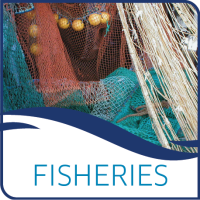The reported sea trials are part of the FISP funded CodSELect project. Apart from the current trials, the project involves a number of controlled laboratory tank trials conducted in the Marine Directorate’s facilities in the Marine Laboratory in Aberdeen as well as sea trials on board the Marine Directorate’s research vessel Alba Na Mara. The trials took place on FV Westro PD20, between 3-9 October 2023, in Neprhops commercial grounds (NE Piper). The data collection was carried out by both Marine Directorate and Scottish Fishermen’s Federation scientific personnel. The objective was to investigate whether artificial light can influence fish behaviour, with main focus on cod, and enhance escape through a square mesh panel (SMP) on the top panel of a SELTRA sorting box in the extension of a commercial trawl.
Data and Resources
- 1223H Haul Data csv
SurveyAcronym: Indicating project name. Allows merging with all other data...
Preview Download - 1223H Catch Length Distribution Data csv
SurveyAcronym: Indicating project name. Allows merging with all other data...
Preview Download - 1223H Catch Weight Data csv
SurveyAcronym: Indicating project name. Allows merging with all other data...
Preview Download - 1223H LI192 Datacsv
SurveyAcronym: Indicating project name. Allows merging with all other data...
Preview Download - 1223H RBR Tu Datacsv
SurveyAcronym: Indicating project name. Allows merging with all other data...
Preview Download
| Field | Value |
|---|---|
| Publisher | |
| Modified | 2024-04-16 |
| Release Date | 2024-04-16 |
| Identifier | 724436f9-c270-4e39-ba4c-18139ddb5aa0 |
| Spatial / Geographical Coverage Area | POLYGON ((0.17578125 57.083105217465, 0.17578125 57.90955876804, 2.61474609375 57.90955876804, 2.61474609375 57.083105217465)) |
| Temporal Coverage | 2023-10-03 to 2023-10-09 |
| Language | English (United Kingdom) |
| License | UK Open Government Licence (OGL) |
| Data Dictionary | Three scientific staff joined the vessel, the Scientist In Charge (SIC) was provided by the Marine Directorate and two further observers from the Scottish Fishermen’s Federation (SFF). The vessel sailed from Peterhead towards the N.Piper grounds (ICES stat.sq. 44F0), an area selected by the vessel’s skipper for its mix of both Nephrops and whitefish. The twin trawl method was used where the vessels standard gear was towed alongside the test gear which was a vessel supplied trawl rigged with a 3 metre SELTRA sorting box. The SELTRA was rigged with a 300 mm SMP on the top panel, 9 metres from the codline, and fibre optic (FO) cables illuminated by Photosynergy’s SLS2500 white (4000K) LED light pods and powered by Photosynergy SBS5000 batteries, on the bottom panel. The decision to conduct two hour tows, instead of the commercial minimum of 4 hours, was deemed a good compromise for commercial operations that would also allow for completion of a sufficient number of hauls, within the limited trial dates, needed for the post cruise statistical analysis. Similarly, due to the limitation in trial days every effort was made to stay on the same fishing grounds to limit time lost travelling and eliminate potential area biases for the subsequent analysis. For the first half of the trip the test gear was deployed on the port side, during daylight hours, switching sides mid-trip to reduce possible side bias. Before commencing each haul a LICOR LI-192SA underwater quantum sensor coupled with a LICOR LI-250A light meter were used to obtain downwelling PAR readings as an indication of ambient light conditions. Three readings were taken, with an interval of 20 seconds between each reading, at the approximate target fishing depth (max ~100 m or if less at ~10 m from the bottom). Turbidity was recorded by an RBR Solo3 logger equipped with a Seapoint turbidity sensor. For the first haul turbidity sensors were placed inside both the control and test trawls but one of the units got damaged during the first haul and subsequent deployments measured turbidity only in the test trawl. On retrieval of the gears the first codend would be emptied into the hopper and once the catch was worked up the second would follow to avoid mixing of the catches. The catches were sorted into key species, weighed and individual total fish length measurements recorded. Fishing operations were carried out during daylight hours with 18 hauls completed, 17 of which were valid. |
| Contact Name | Marine Directorate |
| Contact Email | |
| Public Access Level | Public |


